Business Strategy Report: Vodafone's Market Analysis and Strategies
VerifiedAdded on 2020/10/22
|15
|4945
|131
Report
AI Summary
This report provides a detailed analysis of Vodafone's business strategy, examining its operations within the UK market. The report begins with an introduction to business strategy and its application to Vodafone, an international telecommunications company. It then applies a PESTLE analysis to evaluate the political, economic, social, technological, environmental, and legal factors impacting Vodafone. The report continues with a SWOT analysis to assess Vodafone's strengths, weaknesses, opportunities, and threats. Furthermore, the report explores Porter's Five Forces to assess the competitive landscape and Bowman's strategic theory to evaluate strategic choices. Finally, the report discusses strategic management decisions, objectives for enhancing competitiveness, and a conclusion summarizing the findings. The report aims to provide insights into Vodafone's strategic positioning and decision-making processes.
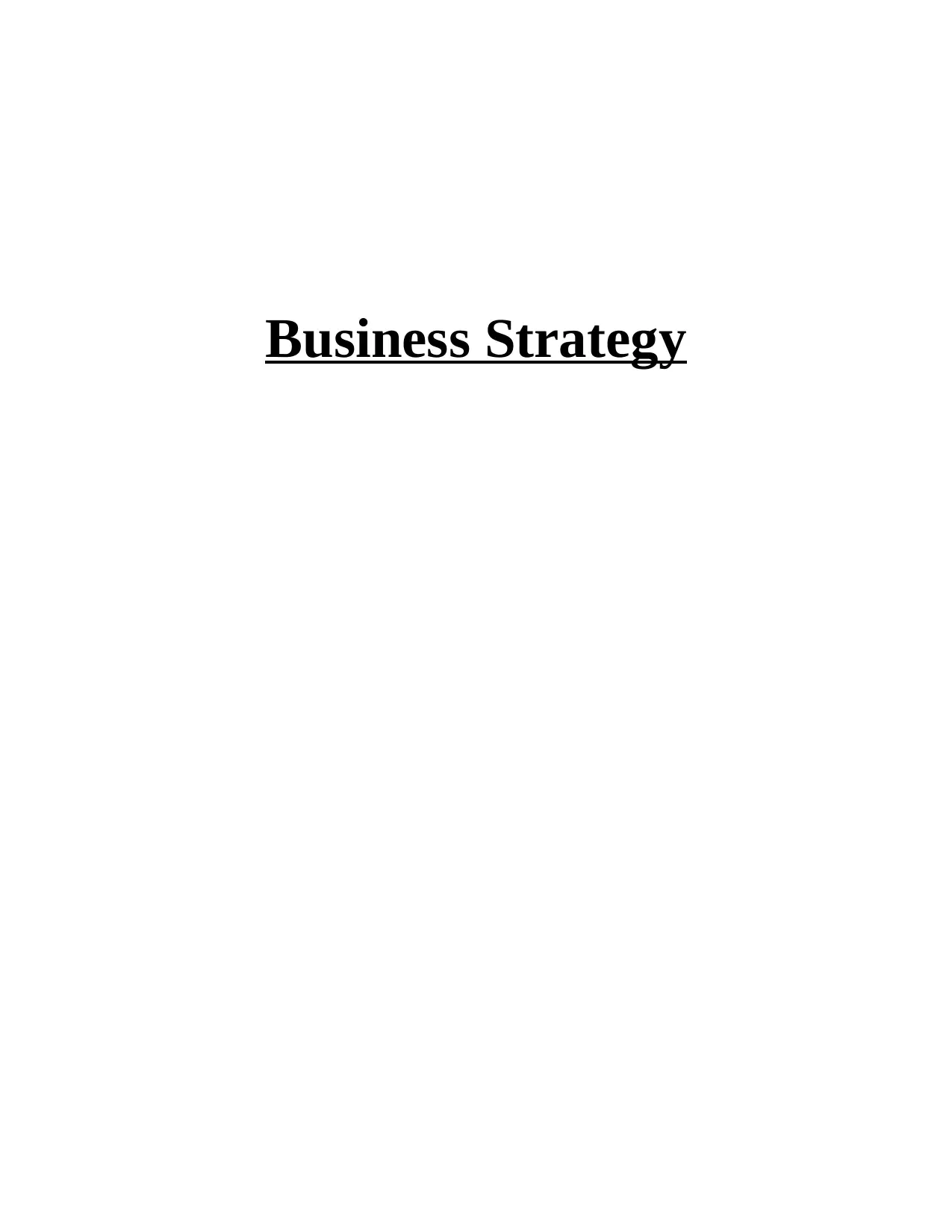
Business Strategy
Paraphrase This Document
Need a fresh take? Get an instant paraphrase of this document with our AI Paraphraser
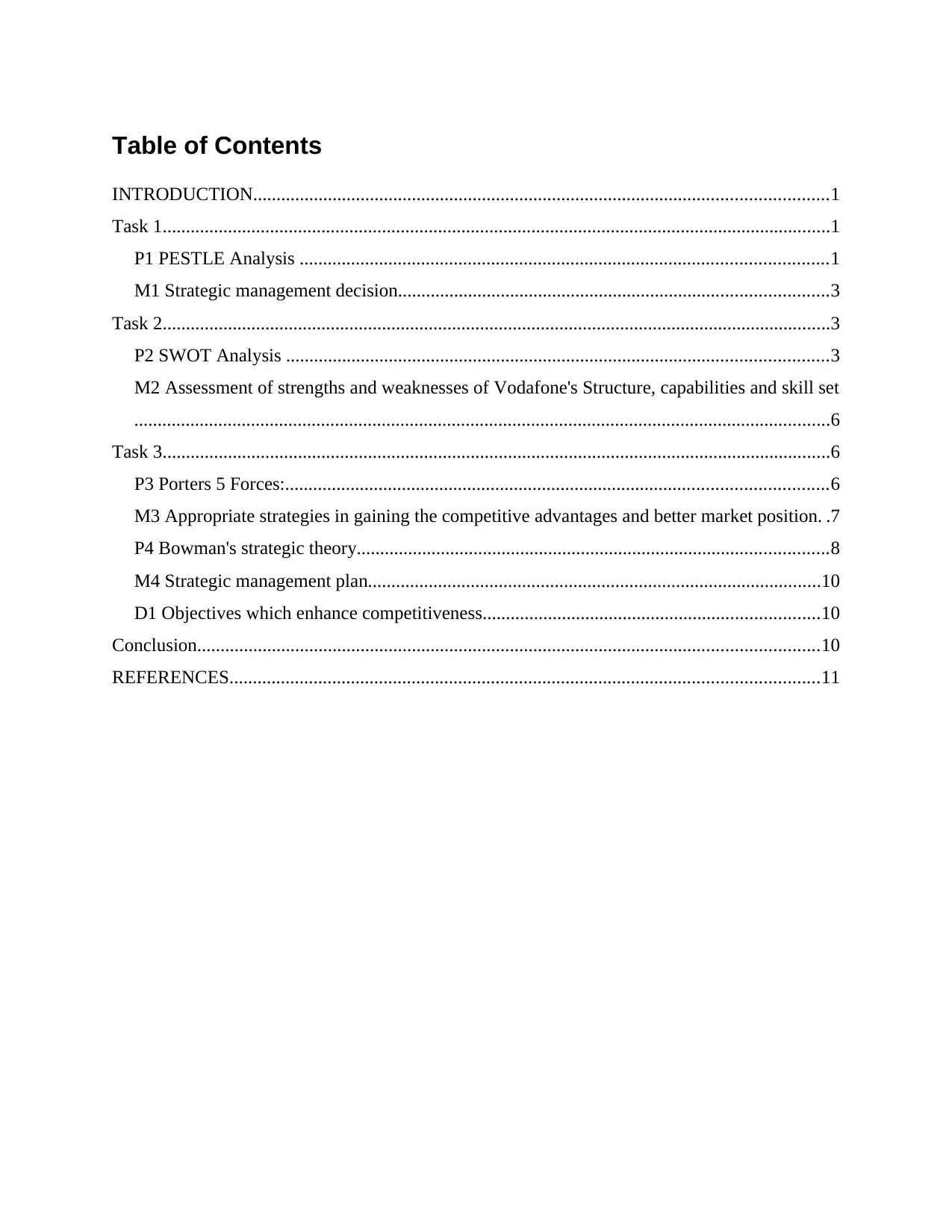
Table of Contents
INTRODUCTION...........................................................................................................................1
Task 1...............................................................................................................................................1
P1 PESTLE Analysis .................................................................................................................1
M1 Strategic management decision............................................................................................3
Task 2...............................................................................................................................................3
P2 SWOT Analysis ....................................................................................................................3
M2 Assessment of strengths and weaknesses of Vodafone's Structure, capabilities and skill set
.....................................................................................................................................................6
Task 3...............................................................................................................................................6
P3 Porters 5 Forces:....................................................................................................................6
M3 Appropriate strategies in gaining the competitive advantages and better market position. .7
P4 Bowman's strategic theory.....................................................................................................8
M4 Strategic management plan.................................................................................................10
D1 Objectives which enhance competitiveness........................................................................10
Conclusion.....................................................................................................................................10
REFERENCES..............................................................................................................................11
INTRODUCTION...........................................................................................................................1
Task 1...............................................................................................................................................1
P1 PESTLE Analysis .................................................................................................................1
M1 Strategic management decision............................................................................................3
Task 2...............................................................................................................................................3
P2 SWOT Analysis ....................................................................................................................3
M2 Assessment of strengths and weaknesses of Vodafone's Structure, capabilities and skill set
.....................................................................................................................................................6
Task 3...............................................................................................................................................6
P3 Porters 5 Forces:....................................................................................................................6
M3 Appropriate strategies in gaining the competitive advantages and better market position. .7
P4 Bowman's strategic theory.....................................................................................................8
M4 Strategic management plan.................................................................................................10
D1 Objectives which enhance competitiveness........................................................................10
Conclusion.....................................................................................................................................10
REFERENCES..............................................................................................................................11
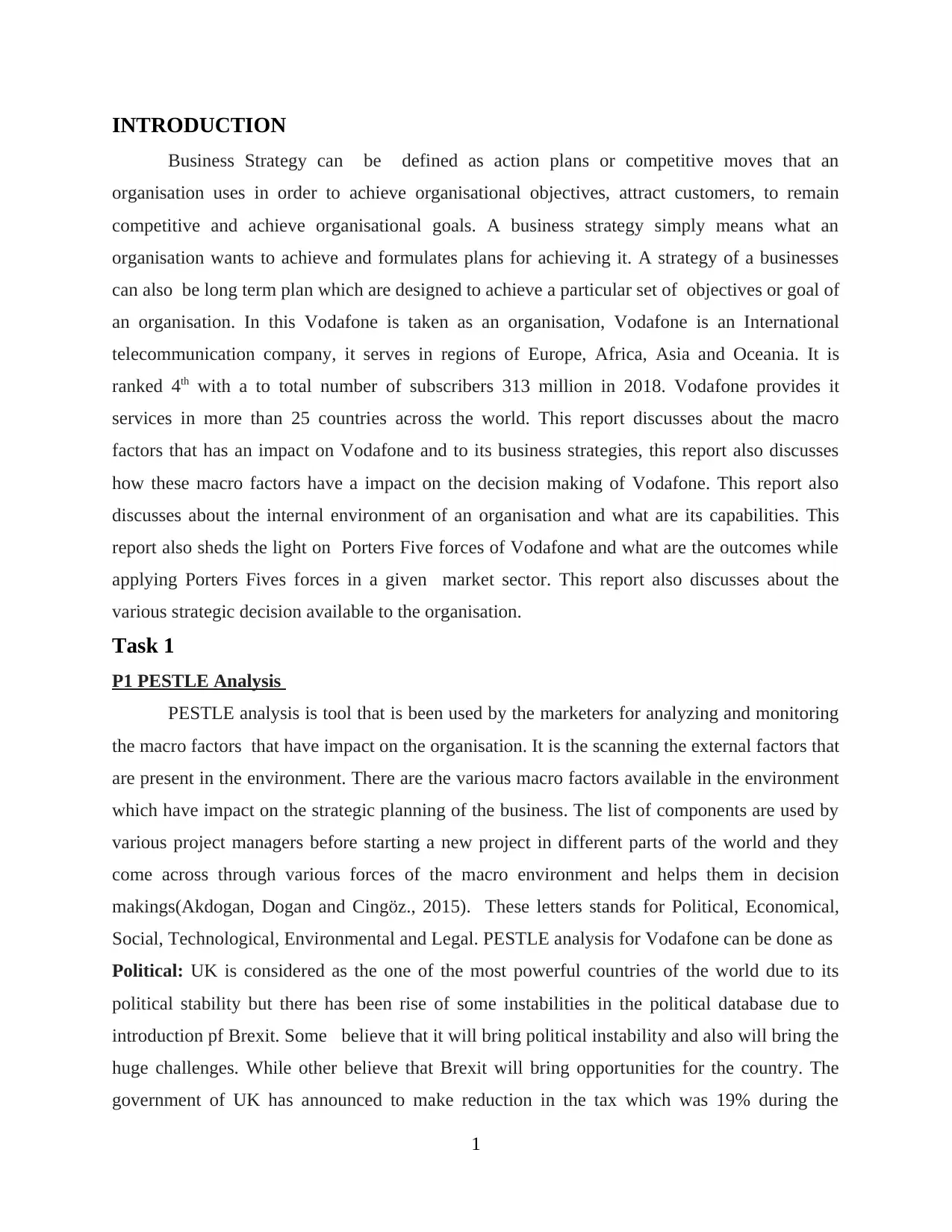
INTRODUCTION
Business Strategy can be defined as action plans or competitive moves that an
organisation uses in order to achieve organisational objectives, attract customers, to remain
competitive and achieve organisational goals. A business strategy simply means what an
organisation wants to achieve and formulates plans for achieving it. A strategy of a businesses
can also be long term plan which are designed to achieve a particular set of objectives or goal of
an organisation. In this Vodafone is taken as an organisation, Vodafone is an International
telecommunication company, it serves in regions of Europe, Africa, Asia and Oceania. It is
ranked 4th with a to total number of subscribers 313 million in 2018. Vodafone provides it
services in more than 25 countries across the world. This report discusses about the macro
factors that has an impact on Vodafone and to its business strategies, this report also discusses
how these macro factors have a impact on the decision making of Vodafone. This report also
discusses about the internal environment of an organisation and what are its capabilities. This
report also sheds the light on Porters Five forces of Vodafone and what are the outcomes while
applying Porters Fives forces in a given market sector. This report also discusses about the
various strategic decision available to the organisation.
Task 1
P1 PESTLE Analysis
PESTLE analysis is tool that is been used by the marketers for analyzing and monitoring
the macro factors that have impact on the organisation. It is the scanning the external factors that
are present in the environment. There are the various macro factors available in the environment
which have impact on the strategic planning of the business. The list of components are used by
various project managers before starting a new project in different parts of the world and they
come across through various forces of the macro environment and helps them in decision
makings(Akdogan, Dogan and Cingöz., 2015). These letters stands for Political, Economical,
Social, Technological, Environmental and Legal. PESTLE analysis for Vodafone can be done as
Political: UK is considered as the one of the most powerful countries of the world due to its
political stability but there has been rise of some instabilities in the political database due to
introduction pf Brexit. Some believe that it will bring political instability and also will bring the
huge challenges. While other believe that Brexit will bring opportunities for the country. The
government of UK has announced to make reduction in the tax which was 19% during the
1
Business Strategy can be defined as action plans or competitive moves that an
organisation uses in order to achieve organisational objectives, attract customers, to remain
competitive and achieve organisational goals. A business strategy simply means what an
organisation wants to achieve and formulates plans for achieving it. A strategy of a businesses
can also be long term plan which are designed to achieve a particular set of objectives or goal of
an organisation. In this Vodafone is taken as an organisation, Vodafone is an International
telecommunication company, it serves in regions of Europe, Africa, Asia and Oceania. It is
ranked 4th with a to total number of subscribers 313 million in 2018. Vodafone provides it
services in more than 25 countries across the world. This report discusses about the macro
factors that has an impact on Vodafone and to its business strategies, this report also discusses
how these macro factors have a impact on the decision making of Vodafone. This report also
discusses about the internal environment of an organisation and what are its capabilities. This
report also sheds the light on Porters Five forces of Vodafone and what are the outcomes while
applying Porters Fives forces in a given market sector. This report also discusses about the
various strategic decision available to the organisation.
Task 1
P1 PESTLE Analysis
PESTLE analysis is tool that is been used by the marketers for analyzing and monitoring
the macro factors that have impact on the organisation. It is the scanning the external factors that
are present in the environment. There are the various macro factors available in the environment
which have impact on the strategic planning of the business. The list of components are used by
various project managers before starting a new project in different parts of the world and they
come across through various forces of the macro environment and helps them in decision
makings(Akdogan, Dogan and Cingöz., 2015). These letters stands for Political, Economical,
Social, Technological, Environmental and Legal. PESTLE analysis for Vodafone can be done as
Political: UK is considered as the one of the most powerful countries of the world due to its
political stability but there has been rise of some instabilities in the political database due to
introduction pf Brexit. Some believe that it will bring political instability and also will bring the
huge challenges. While other believe that Brexit will bring opportunities for the country. The
government of UK has announced to make reduction in the tax which was 19% during the
1
⊘ This is a preview!⊘
Do you want full access?
Subscribe today to unlock all pages.

Trusted by 1+ million students worldwide
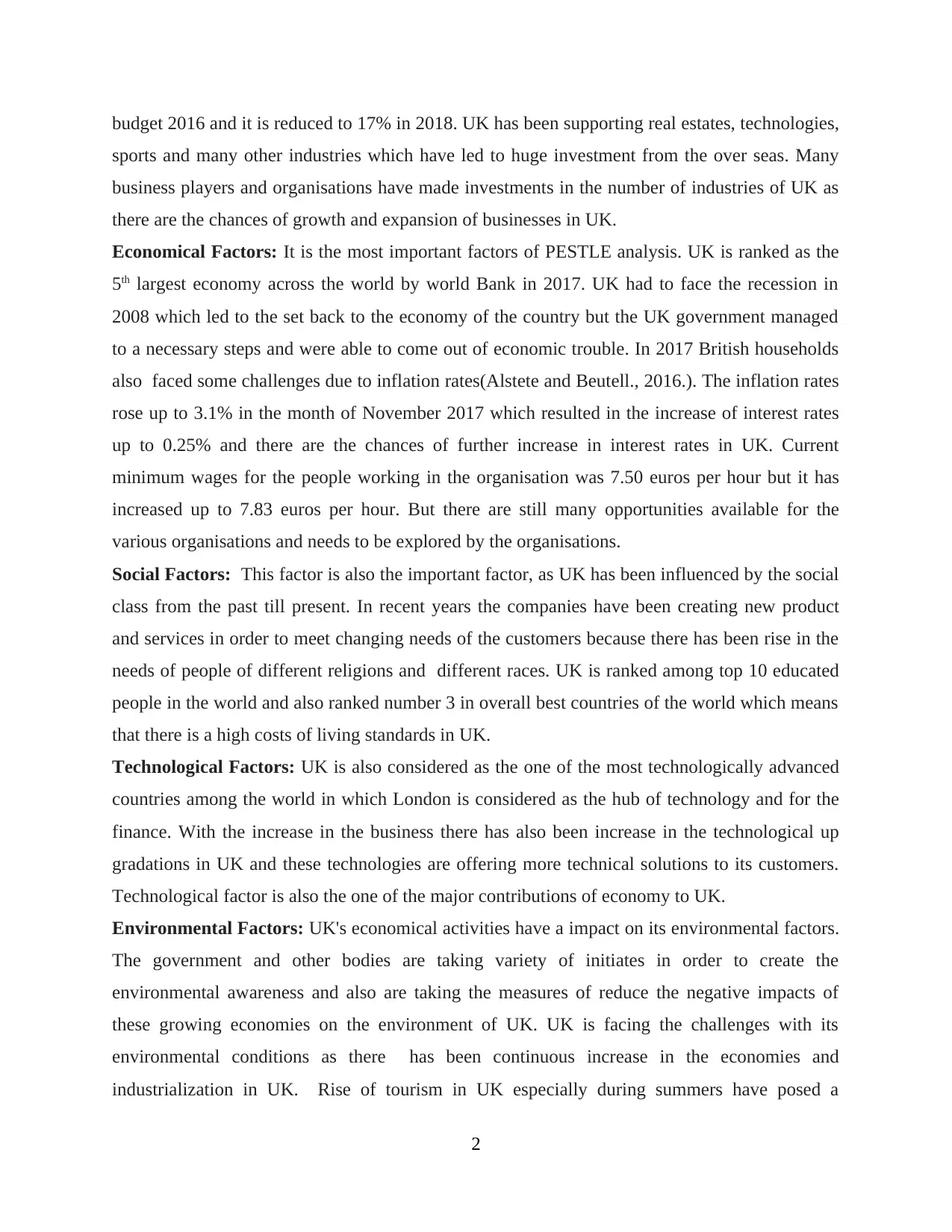
budget 2016 and it is reduced to 17% in 2018. UK has been supporting real estates, technologies,
sports and many other industries which have led to huge investment from the over seas. Many
business players and organisations have made investments in the number of industries of UK as
there are the chances of growth and expansion of businesses in UK.
Economical Factors: It is the most important factors of PESTLE analysis. UK is ranked as the
5th largest economy across the world by world Bank in 2017. UK had to face the recession in
2008 which led to the set back to the economy of the country but the UK government managed
to a necessary steps and were able to come out of economic trouble. In 2017 British households
also faced some challenges due to inflation rates(Alstete and Beutell., 2016.). The inflation rates
rose up to 3.1% in the month of November 2017 which resulted in the increase of interest rates
up to 0.25% and there are the chances of further increase in interest rates in UK. Current
minimum wages for the people working in the organisation was 7.50 euros per hour but it has
increased up to 7.83 euros per hour. But there are still many opportunities available for the
various organisations and needs to be explored by the organisations.
Social Factors: This factor is also the important factor, as UK has been influenced by the social
class from the past till present. In recent years the companies have been creating new product
and services in order to meet changing needs of the customers because there has been rise in the
needs of people of different religions and different races. UK is ranked among top 10 educated
people in the world and also ranked number 3 in overall best countries of the world which means
that there is a high costs of living standards in UK.
Technological Factors: UK is also considered as the one of the most technologically advanced
countries among the world in which London is considered as the hub of technology and for the
finance. With the increase in the business there has also been increase in the technological up
gradations in UK and these technologies are offering more technical solutions to its customers.
Technological factor is also the one of the major contributions of economy to UK.
Environmental Factors: UK's economical activities have a impact on its environmental factors.
The government and other bodies are taking variety of initiates in order to create the
environmental awareness and also are taking the measures of reduce the negative impacts of
these growing economies on the environment of UK. UK is facing the challenges with its
environmental conditions as there has been continuous increase in the economies and
industrialization in UK. Rise of tourism in UK especially during summers have posed a
2
sports and many other industries which have led to huge investment from the over seas. Many
business players and organisations have made investments in the number of industries of UK as
there are the chances of growth and expansion of businesses in UK.
Economical Factors: It is the most important factors of PESTLE analysis. UK is ranked as the
5th largest economy across the world by world Bank in 2017. UK had to face the recession in
2008 which led to the set back to the economy of the country but the UK government managed
to a necessary steps and were able to come out of economic trouble. In 2017 British households
also faced some challenges due to inflation rates(Alstete and Beutell., 2016.). The inflation rates
rose up to 3.1% in the month of November 2017 which resulted in the increase of interest rates
up to 0.25% and there are the chances of further increase in interest rates in UK. Current
minimum wages for the people working in the organisation was 7.50 euros per hour but it has
increased up to 7.83 euros per hour. But there are still many opportunities available for the
various organisations and needs to be explored by the organisations.
Social Factors: This factor is also the important factor, as UK has been influenced by the social
class from the past till present. In recent years the companies have been creating new product
and services in order to meet changing needs of the customers because there has been rise in the
needs of people of different religions and different races. UK is ranked among top 10 educated
people in the world and also ranked number 3 in overall best countries of the world which means
that there is a high costs of living standards in UK.
Technological Factors: UK is also considered as the one of the most technologically advanced
countries among the world in which London is considered as the hub of technology and for the
finance. With the increase in the business there has also been increase in the technological up
gradations in UK and these technologies are offering more technical solutions to its customers.
Technological factor is also the one of the major contributions of economy to UK.
Environmental Factors: UK's economical activities have a impact on its environmental factors.
The government and other bodies are taking variety of initiates in order to create the
environmental awareness and also are taking the measures of reduce the negative impacts of
these growing economies on the environment of UK. UK is facing the challenges with its
environmental conditions as there has been continuous increase in the economies and
industrialization in UK. Rise of tourism in UK especially during summers have posed a
2
Paraphrase This Document
Need a fresh take? Get an instant paraphrase of this document with our AI Paraphraser
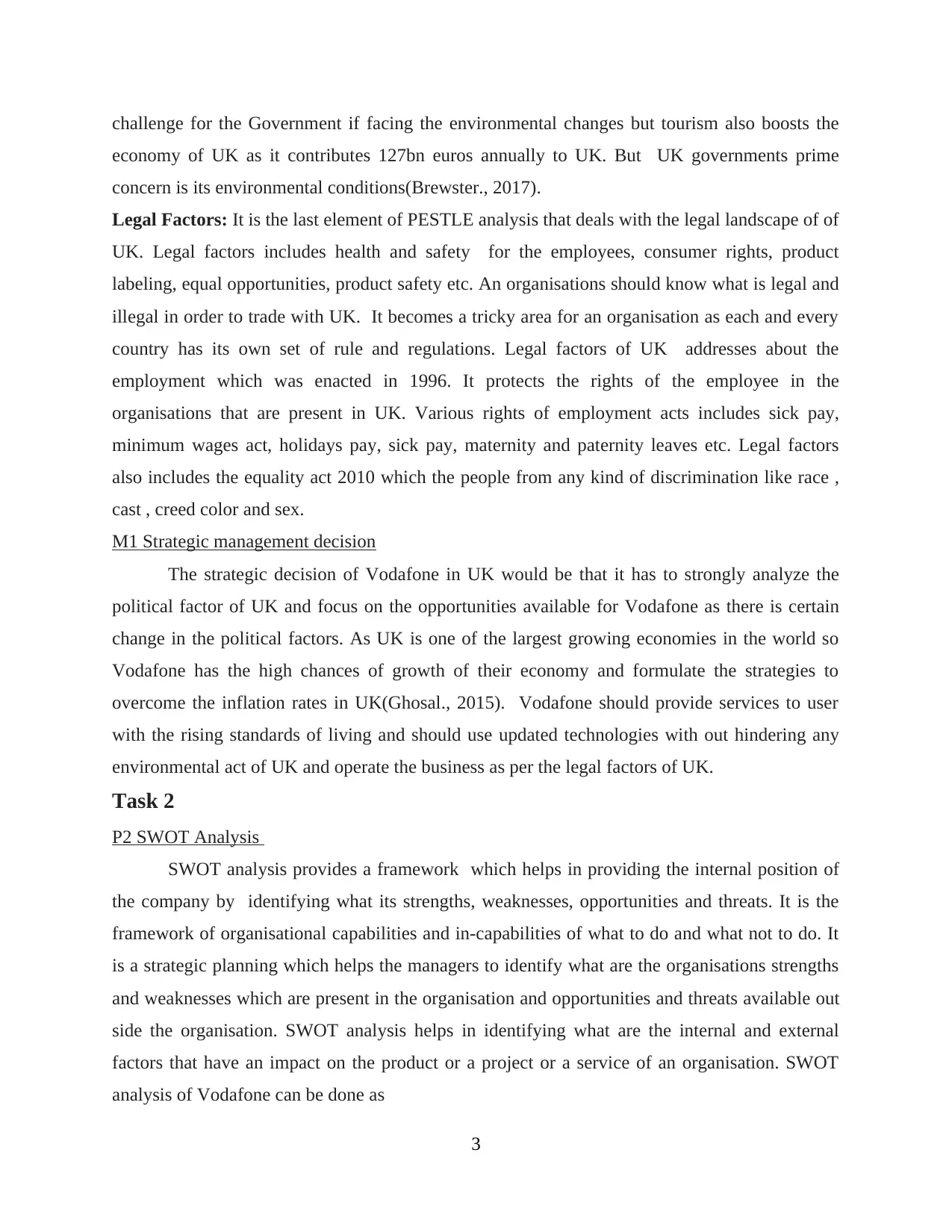
challenge for the Government if facing the environmental changes but tourism also boosts the
economy of UK as it contributes 127bn euros annually to UK. But UK governments prime
concern is its environmental conditions(Brewster., 2017).
Legal Factors: It is the last element of PESTLE analysis that deals with the legal landscape of of
UK. Legal factors includes health and safety for the employees, consumer rights, product
labeling, equal opportunities, product safety etc. An organisations should know what is legal and
illegal in order to trade with UK. It becomes a tricky area for an organisation as each and every
country has its own set of rule and regulations. Legal factors of UK addresses about the
employment which was enacted in 1996. It protects the rights of the employee in the
organisations that are present in UK. Various rights of employment acts includes sick pay,
minimum wages act, holidays pay, sick pay, maternity and paternity leaves etc. Legal factors
also includes the equality act 2010 which the people from any kind of discrimination like race ,
cast , creed color and sex.
M1 Strategic management decision
The strategic decision of Vodafone in UK would be that it has to strongly analyze the
political factor of UK and focus on the opportunities available for Vodafone as there is certain
change in the political factors. As UK is one of the largest growing economies in the world so
Vodafone has the high chances of growth of their economy and formulate the strategies to
overcome the inflation rates in UK(Ghosal., 2015). Vodafone should provide services to user
with the rising standards of living and should use updated technologies with out hindering any
environmental act of UK and operate the business as per the legal factors of UK.
Task 2
P2 SWOT Analysis
SWOT analysis provides a framework which helps in providing the internal position of
the company by identifying what its strengths, weaknesses, opportunities and threats. It is the
framework of organisational capabilities and in-capabilities of what to do and what not to do. It
is a strategic planning which helps the managers to identify what are the organisations strengths
and weaknesses which are present in the organisation and opportunities and threats available out
side the organisation. SWOT analysis helps in identifying what are the internal and external
factors that have an impact on the product or a project or a service of an organisation. SWOT
analysis of Vodafone can be done as
3
economy of UK as it contributes 127bn euros annually to UK. But UK governments prime
concern is its environmental conditions(Brewster., 2017).
Legal Factors: It is the last element of PESTLE analysis that deals with the legal landscape of of
UK. Legal factors includes health and safety for the employees, consumer rights, product
labeling, equal opportunities, product safety etc. An organisations should know what is legal and
illegal in order to trade with UK. It becomes a tricky area for an organisation as each and every
country has its own set of rule and regulations. Legal factors of UK addresses about the
employment which was enacted in 1996. It protects the rights of the employee in the
organisations that are present in UK. Various rights of employment acts includes sick pay,
minimum wages act, holidays pay, sick pay, maternity and paternity leaves etc. Legal factors
also includes the equality act 2010 which the people from any kind of discrimination like race ,
cast , creed color and sex.
M1 Strategic management decision
The strategic decision of Vodafone in UK would be that it has to strongly analyze the
political factor of UK and focus on the opportunities available for Vodafone as there is certain
change in the political factors. As UK is one of the largest growing economies in the world so
Vodafone has the high chances of growth of their economy and formulate the strategies to
overcome the inflation rates in UK(Ghosal., 2015). Vodafone should provide services to user
with the rising standards of living and should use updated technologies with out hindering any
environmental act of UK and operate the business as per the legal factors of UK.
Task 2
P2 SWOT Analysis
SWOT analysis provides a framework which helps in providing the internal position of
the company by identifying what its strengths, weaknesses, opportunities and threats. It is the
framework of organisational capabilities and in-capabilities of what to do and what not to do. It
is a strategic planning which helps the managers to identify what are the organisations strengths
and weaknesses which are present in the organisation and opportunities and threats available out
side the organisation. SWOT analysis helps in identifying what are the internal and external
factors that have an impact on the product or a project or a service of an organisation. SWOT
analysis of Vodafone can be done as
3
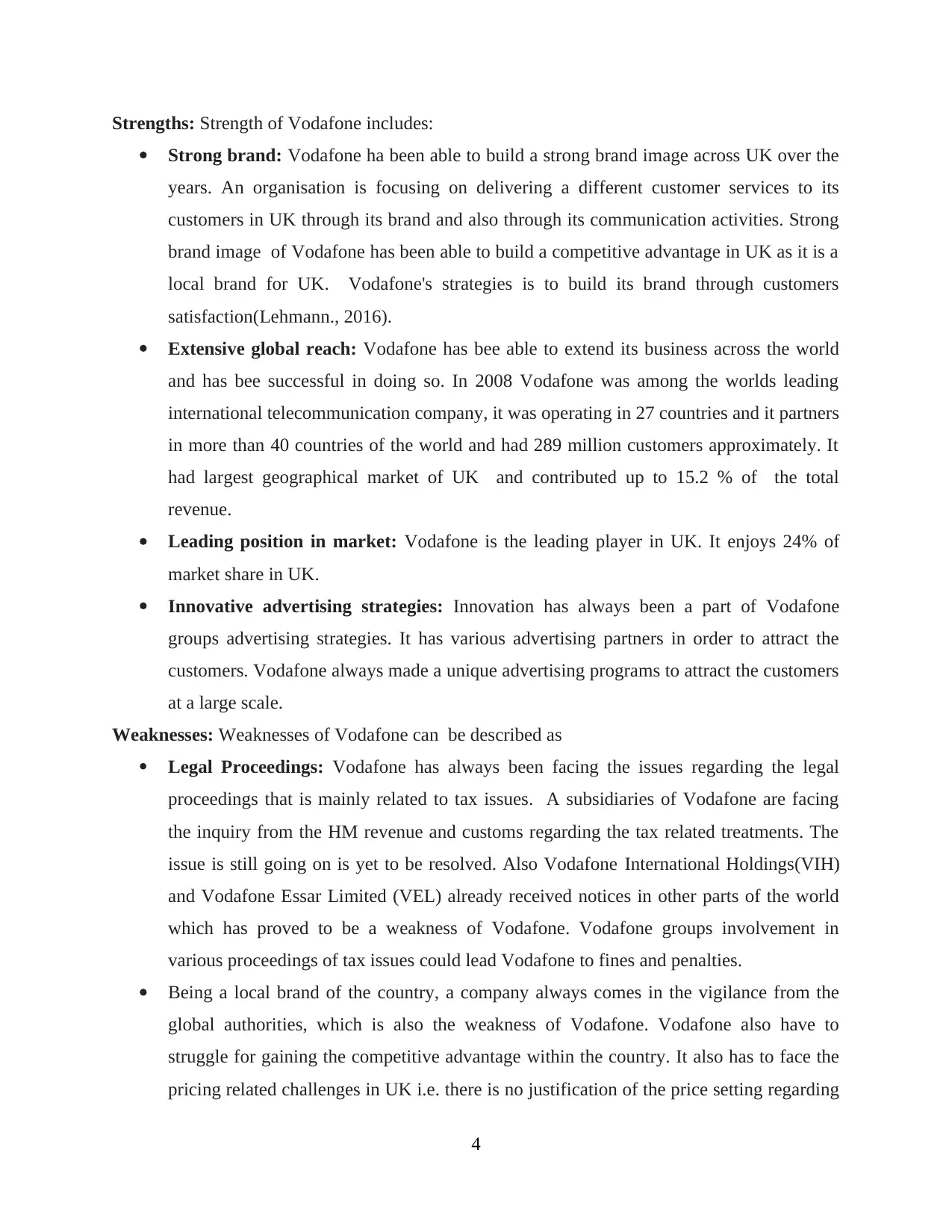
Strengths: Strength of Vodafone includes:
Strong brand: Vodafone ha been able to build a strong brand image across UK over the
years. An organisation is focusing on delivering a different customer services to its
customers in UK through its brand and also through its communication activities. Strong
brand image of Vodafone has been able to build a competitive advantage in UK as it is a
local brand for UK. Vodafone's strategies is to build its brand through customers
satisfaction(Lehmann., 2016).
Extensive global reach: Vodafone has bee able to extend its business across the world
and has bee successful in doing so. In 2008 Vodafone was among the worlds leading
international telecommunication company, it was operating in 27 countries and it partners
in more than 40 countries of the world and had 289 million customers approximately. It
had largest geographical market of UK and contributed up to 15.2 % of the total
revenue.
Leading position in market: Vodafone is the leading player in UK. It enjoys 24% of
market share in UK.
Innovative advertising strategies: Innovation has always been a part of Vodafone
groups advertising strategies. It has various advertising partners in order to attract the
customers. Vodafone always made a unique advertising programs to attract the customers
at a large scale.
Weaknesses: Weaknesses of Vodafone can be described as
Legal Proceedings: Vodafone has always been facing the issues regarding the legal
proceedings that is mainly related to tax issues. A subsidiaries of Vodafone are facing
the inquiry from the HM revenue and customs regarding the tax related treatments. The
issue is still going on is yet to be resolved. Also Vodafone International Holdings(VIH)
and Vodafone Essar Limited (VEL) already received notices in other parts of the world
which has proved to be a weakness of Vodafone. Vodafone groups involvement in
various proceedings of tax issues could lead Vodafone to fines and penalties.
Being a local brand of the country, a company always comes in the vigilance from the
global authorities, which is also the weakness of Vodafone. Vodafone also have to
struggle for gaining the competitive advantage within the country. It also has to face the
pricing related challenges in UK i.e. there is no justification of the price setting regarding
4
Strong brand: Vodafone ha been able to build a strong brand image across UK over the
years. An organisation is focusing on delivering a different customer services to its
customers in UK through its brand and also through its communication activities. Strong
brand image of Vodafone has been able to build a competitive advantage in UK as it is a
local brand for UK. Vodafone's strategies is to build its brand through customers
satisfaction(Lehmann., 2016).
Extensive global reach: Vodafone has bee able to extend its business across the world
and has bee successful in doing so. In 2008 Vodafone was among the worlds leading
international telecommunication company, it was operating in 27 countries and it partners
in more than 40 countries of the world and had 289 million customers approximately. It
had largest geographical market of UK and contributed up to 15.2 % of the total
revenue.
Leading position in market: Vodafone is the leading player in UK. It enjoys 24% of
market share in UK.
Innovative advertising strategies: Innovation has always been a part of Vodafone
groups advertising strategies. It has various advertising partners in order to attract the
customers. Vodafone always made a unique advertising programs to attract the customers
at a large scale.
Weaknesses: Weaknesses of Vodafone can be described as
Legal Proceedings: Vodafone has always been facing the issues regarding the legal
proceedings that is mainly related to tax issues. A subsidiaries of Vodafone are facing
the inquiry from the HM revenue and customs regarding the tax related treatments. The
issue is still going on is yet to be resolved. Also Vodafone International Holdings(VIH)
and Vodafone Essar Limited (VEL) already received notices in other parts of the world
which has proved to be a weakness of Vodafone. Vodafone groups involvement in
various proceedings of tax issues could lead Vodafone to fines and penalties.
Being a local brand of the country, a company always comes in the vigilance from the
global authorities, which is also the weakness of Vodafone. Vodafone also have to
struggle for gaining the competitive advantage within the country. It also has to face the
pricing related challenges in UK i.e. there is no justification of the price setting regarding
4
⊘ This is a preview!⊘
Do you want full access?
Subscribe today to unlock all pages.

Trusted by 1+ million students worldwide
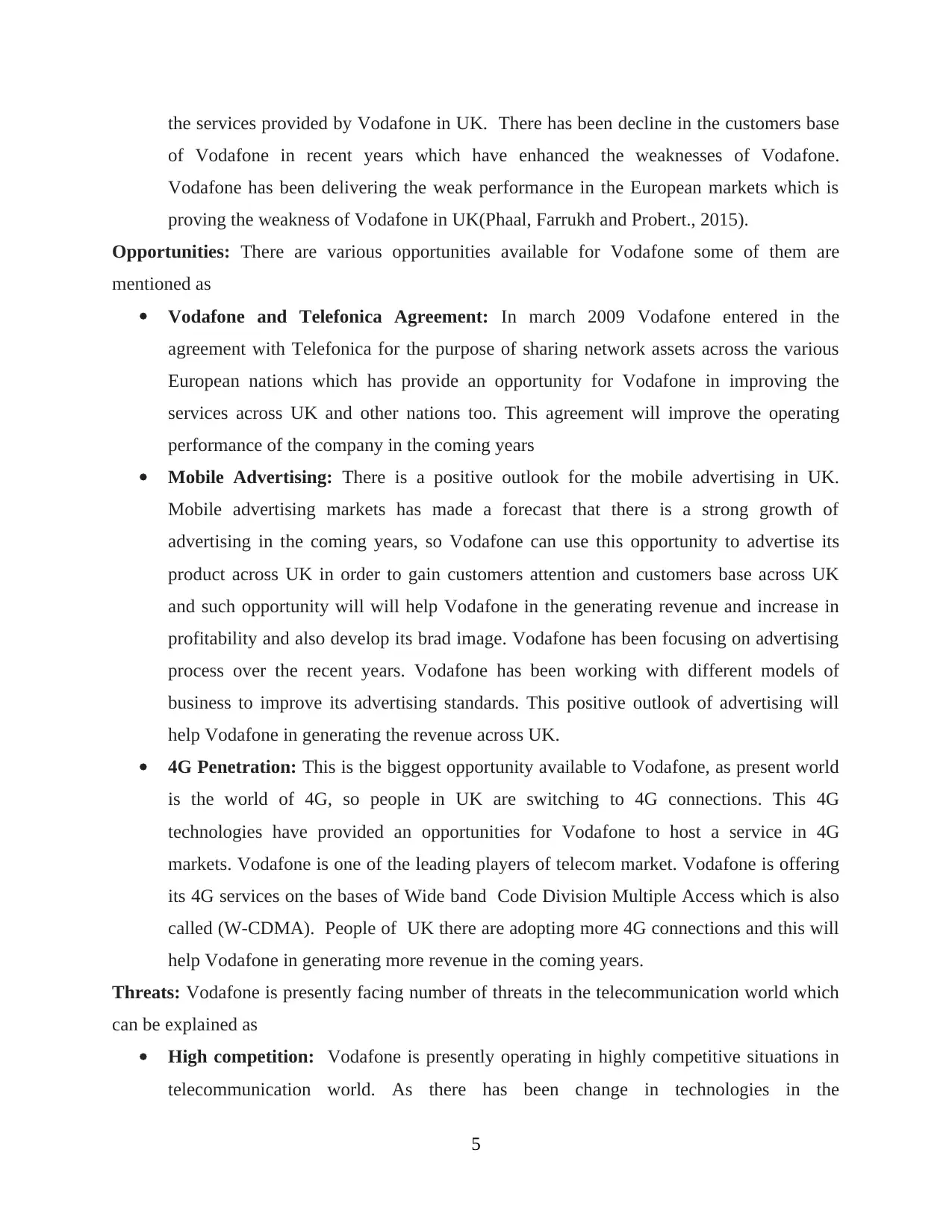
the services provided by Vodafone in UK. There has been decline in the customers base
of Vodafone in recent years which have enhanced the weaknesses of Vodafone.
Vodafone has been delivering the weak performance in the European markets which is
proving the weakness of Vodafone in UK(Phaal, Farrukh and Probert., 2015).
Opportunities: There are various opportunities available for Vodafone some of them are
mentioned as
Vodafone and Telefonica Agreement: In march 2009 Vodafone entered in the
agreement with Telefonica for the purpose of sharing network assets across the various
European nations which has provide an opportunity for Vodafone in improving the
services across UK and other nations too. This agreement will improve the operating
performance of the company in the coming years
Mobile Advertising: There is a positive outlook for the mobile advertising in UK.
Mobile advertising markets has made a forecast that there is a strong growth of
advertising in the coming years, so Vodafone can use this opportunity to advertise its
product across UK in order to gain customers attention and customers base across UK
and such opportunity will will help Vodafone in the generating revenue and increase in
profitability and also develop its brad image. Vodafone has been focusing on advertising
process over the recent years. Vodafone has been working with different models of
business to improve its advertising standards. This positive outlook of advertising will
help Vodafone in generating the revenue across UK.
4G Penetration: This is the biggest opportunity available to Vodafone, as present world
is the world of 4G, so people in UK are switching to 4G connections. This 4G
technologies have provided an opportunities for Vodafone to host a service in 4G
markets. Vodafone is one of the leading players of telecom market. Vodafone is offering
its 4G services on the bases of Wide band Code Division Multiple Access which is also
called (W-CDMA). People of UK there are adopting more 4G connections and this will
help Vodafone in generating more revenue in the coming years.
Threats: Vodafone is presently facing number of threats in the telecommunication world which
can be explained as
High competition: Vodafone is presently operating in highly competitive situations in
telecommunication world. As there has been change in technologies in the
5
of Vodafone in recent years which have enhanced the weaknesses of Vodafone.
Vodafone has been delivering the weak performance in the European markets which is
proving the weakness of Vodafone in UK(Phaal, Farrukh and Probert., 2015).
Opportunities: There are various opportunities available for Vodafone some of them are
mentioned as
Vodafone and Telefonica Agreement: In march 2009 Vodafone entered in the
agreement with Telefonica for the purpose of sharing network assets across the various
European nations which has provide an opportunity for Vodafone in improving the
services across UK and other nations too. This agreement will improve the operating
performance of the company in the coming years
Mobile Advertising: There is a positive outlook for the mobile advertising in UK.
Mobile advertising markets has made a forecast that there is a strong growth of
advertising in the coming years, so Vodafone can use this opportunity to advertise its
product across UK in order to gain customers attention and customers base across UK
and such opportunity will will help Vodafone in the generating revenue and increase in
profitability and also develop its brad image. Vodafone has been focusing on advertising
process over the recent years. Vodafone has been working with different models of
business to improve its advertising standards. This positive outlook of advertising will
help Vodafone in generating the revenue across UK.
4G Penetration: This is the biggest opportunity available to Vodafone, as present world
is the world of 4G, so people in UK are switching to 4G connections. This 4G
technologies have provided an opportunities for Vodafone to host a service in 4G
markets. Vodafone is one of the leading players of telecom market. Vodafone is offering
its 4G services on the bases of Wide band Code Division Multiple Access which is also
called (W-CDMA). People of UK there are adopting more 4G connections and this will
help Vodafone in generating more revenue in the coming years.
Threats: Vodafone is presently facing number of threats in the telecommunication world which
can be explained as
High competition: Vodafone is presently operating in highly competitive situations in
telecommunication world. As there has been change in technologies in the
5
Paraphrase This Document
Need a fresh take? Get an instant paraphrase of this document with our AI Paraphraser
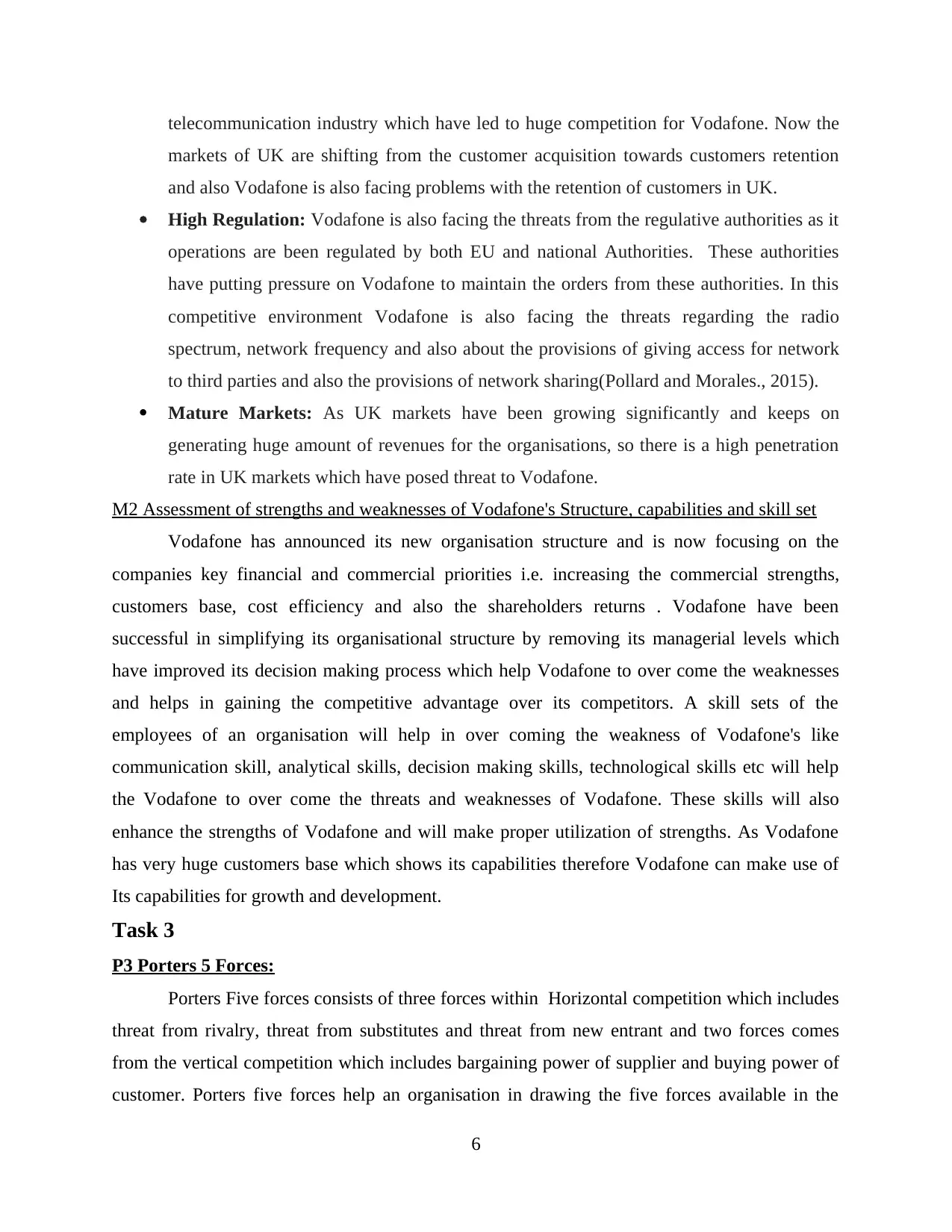
telecommunication industry which have led to huge competition for Vodafone. Now the
markets of UK are shifting from the customer acquisition towards customers retention
and also Vodafone is also facing problems with the retention of customers in UK.
High Regulation: Vodafone is also facing the threats from the regulative authorities as it
operations are been regulated by both EU and national Authorities. These authorities
have putting pressure on Vodafone to maintain the orders from these authorities. In this
competitive environment Vodafone is also facing the threats regarding the radio
spectrum, network frequency and also about the provisions of giving access for network
to third parties and also the provisions of network sharing(Pollard and Morales., 2015).
Mature Markets: As UK markets have been growing significantly and keeps on
generating huge amount of revenues for the organisations, so there is a high penetration
rate in UK markets which have posed threat to Vodafone.
M2 Assessment of strengths and weaknesses of Vodafone's Structure, capabilities and skill set
Vodafone has announced its new organisation structure and is now focusing on the
companies key financial and commercial priorities i.e. increasing the commercial strengths,
customers base, cost efficiency and also the shareholders returns . Vodafone have been
successful in simplifying its organisational structure by removing its managerial levels which
have improved its decision making process which help Vodafone to over come the weaknesses
and helps in gaining the competitive advantage over its competitors. A skill sets of the
employees of an organisation will help in over coming the weakness of Vodafone's like
communication skill, analytical skills, decision making skills, technological skills etc will help
the Vodafone to over come the threats and weaknesses of Vodafone. These skills will also
enhance the strengths of Vodafone and will make proper utilization of strengths. As Vodafone
has very huge customers base which shows its capabilities therefore Vodafone can make use of
Its capabilities for growth and development.
Task 3
P3 Porters 5 Forces:
Porters Five forces consists of three forces within Horizontal competition which includes
threat from rivalry, threat from substitutes and threat from new entrant and two forces comes
from the vertical competition which includes bargaining power of supplier and buying power of
customer. Porters five forces help an organisation in drawing the five forces available in the
6
markets of UK are shifting from the customer acquisition towards customers retention
and also Vodafone is also facing problems with the retention of customers in UK.
High Regulation: Vodafone is also facing the threats from the regulative authorities as it
operations are been regulated by both EU and national Authorities. These authorities
have putting pressure on Vodafone to maintain the orders from these authorities. In this
competitive environment Vodafone is also facing the threats regarding the radio
spectrum, network frequency and also about the provisions of giving access for network
to third parties and also the provisions of network sharing(Pollard and Morales., 2015).
Mature Markets: As UK markets have been growing significantly and keeps on
generating huge amount of revenues for the organisations, so there is a high penetration
rate in UK markets which have posed threat to Vodafone.
M2 Assessment of strengths and weaknesses of Vodafone's Structure, capabilities and skill set
Vodafone has announced its new organisation structure and is now focusing on the
companies key financial and commercial priorities i.e. increasing the commercial strengths,
customers base, cost efficiency and also the shareholders returns . Vodafone have been
successful in simplifying its organisational structure by removing its managerial levels which
have improved its decision making process which help Vodafone to over come the weaknesses
and helps in gaining the competitive advantage over its competitors. A skill sets of the
employees of an organisation will help in over coming the weakness of Vodafone's like
communication skill, analytical skills, decision making skills, technological skills etc will help
the Vodafone to over come the threats and weaknesses of Vodafone. These skills will also
enhance the strengths of Vodafone and will make proper utilization of strengths. As Vodafone
has very huge customers base which shows its capabilities therefore Vodafone can make use of
Its capabilities for growth and development.
Task 3
P3 Porters 5 Forces:
Porters Five forces consists of three forces within Horizontal competition which includes
threat from rivalry, threat from substitutes and threat from new entrant and two forces comes
from the vertical competition which includes bargaining power of supplier and buying power of
customer. Porters five forces help an organisation in drawing the five forces available in the
6
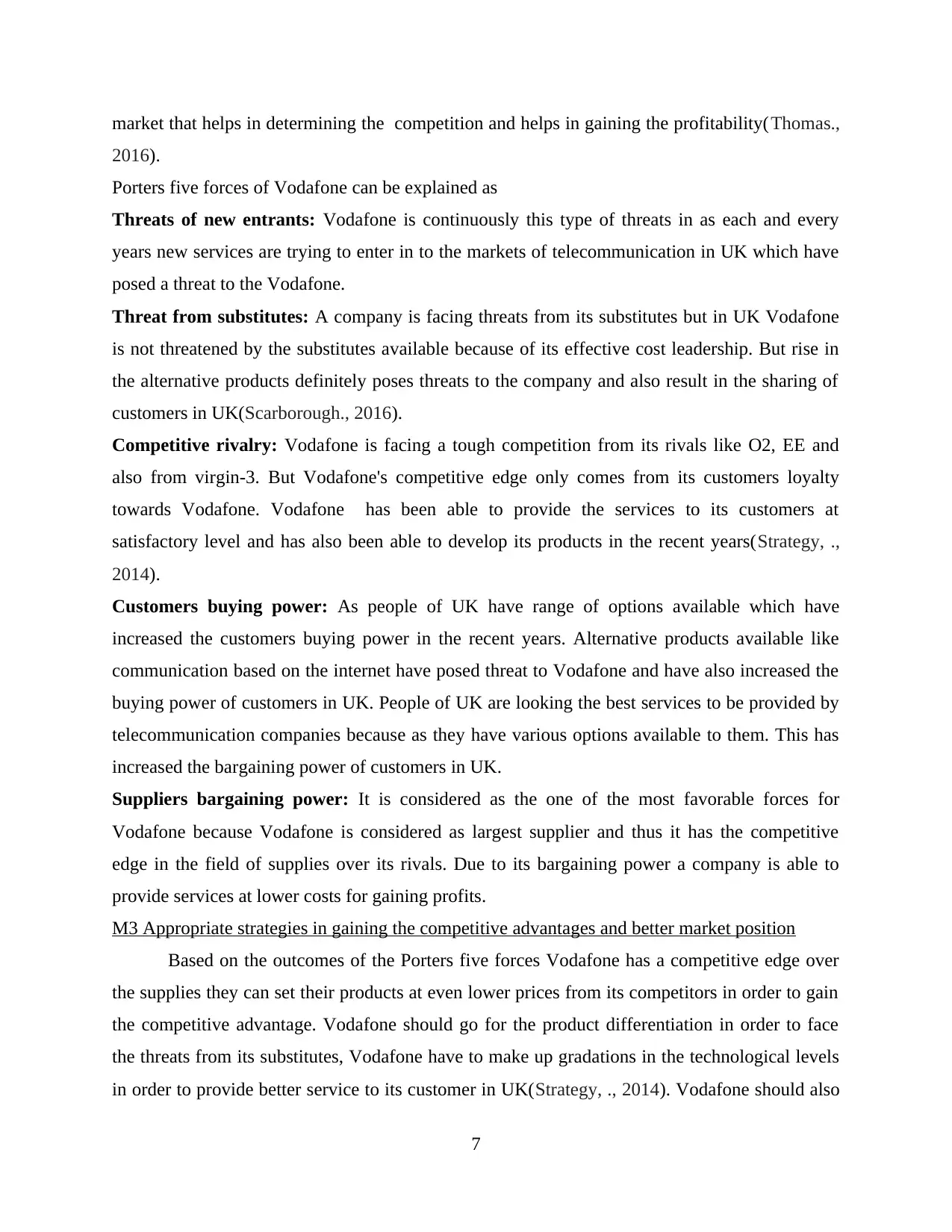
market that helps in determining the competition and helps in gaining the profitability(Thomas.,
2016).
Porters five forces of Vodafone can be explained as
Threats of new entrants: Vodafone is continuously this type of threats in as each and every
years new services are trying to enter in to the markets of telecommunication in UK which have
posed a threat to the Vodafone.
Threat from substitutes: A company is facing threats from its substitutes but in UK Vodafone
is not threatened by the substitutes available because of its effective cost leadership. But rise in
the alternative products definitely poses threats to the company and also result in the sharing of
customers in UK(Scarborough., 2016).
Competitive rivalry: Vodafone is facing a tough competition from its rivals like O2, EE and
also from virgin-3. But Vodafone's competitive edge only comes from its customers loyalty
towards Vodafone. Vodafone has been able to provide the services to its customers at
satisfactory level and has also been able to develop its products in the recent years(Strategy, .,
2014).
Customers buying power: As people of UK have range of options available which have
increased the customers buying power in the recent years. Alternative products available like
communication based on the internet have posed threat to Vodafone and have also increased the
buying power of customers in UK. People of UK are looking the best services to be provided by
telecommunication companies because as they have various options available to them. This has
increased the bargaining power of customers in UK.
Suppliers bargaining power: It is considered as the one of the most favorable forces for
Vodafone because Vodafone is considered as largest supplier and thus it has the competitive
edge in the field of supplies over its rivals. Due to its bargaining power a company is able to
provide services at lower costs for gaining profits.
M3 Appropriate strategies in gaining the competitive advantages and better market position
Based on the outcomes of the Porters five forces Vodafone has a competitive edge over
the supplies they can set their products at even lower prices from its competitors in order to gain
the competitive advantage. Vodafone should go for the product differentiation in order to face
the threats from its substitutes, Vodafone have to make up gradations in the technological levels
in order to provide better service to its customer in UK(Strategy, ., 2014). Vodafone should also
7
2016).
Porters five forces of Vodafone can be explained as
Threats of new entrants: Vodafone is continuously this type of threats in as each and every
years new services are trying to enter in to the markets of telecommunication in UK which have
posed a threat to the Vodafone.
Threat from substitutes: A company is facing threats from its substitutes but in UK Vodafone
is not threatened by the substitutes available because of its effective cost leadership. But rise in
the alternative products definitely poses threats to the company and also result in the sharing of
customers in UK(Scarborough., 2016).
Competitive rivalry: Vodafone is facing a tough competition from its rivals like O2, EE and
also from virgin-3. But Vodafone's competitive edge only comes from its customers loyalty
towards Vodafone. Vodafone has been able to provide the services to its customers at
satisfactory level and has also been able to develop its products in the recent years(Strategy, .,
2014).
Customers buying power: As people of UK have range of options available which have
increased the customers buying power in the recent years. Alternative products available like
communication based on the internet have posed threat to Vodafone and have also increased the
buying power of customers in UK. People of UK are looking the best services to be provided by
telecommunication companies because as they have various options available to them. This has
increased the bargaining power of customers in UK.
Suppliers bargaining power: It is considered as the one of the most favorable forces for
Vodafone because Vodafone is considered as largest supplier and thus it has the competitive
edge in the field of supplies over its rivals. Due to its bargaining power a company is able to
provide services at lower costs for gaining profits.
M3 Appropriate strategies in gaining the competitive advantages and better market position
Based on the outcomes of the Porters five forces Vodafone has a competitive edge over
the supplies they can set their products at even lower prices from its competitors in order to gain
the competitive advantage. Vodafone should go for the product differentiation in order to face
the threats from its substitutes, Vodafone have to make up gradations in the technological levels
in order to provide better service to its customer in UK(Strategy, ., 2014). Vodafone should also
7
⊘ This is a preview!⊘
Do you want full access?
Subscribe today to unlock all pages.

Trusted by 1+ million students worldwide
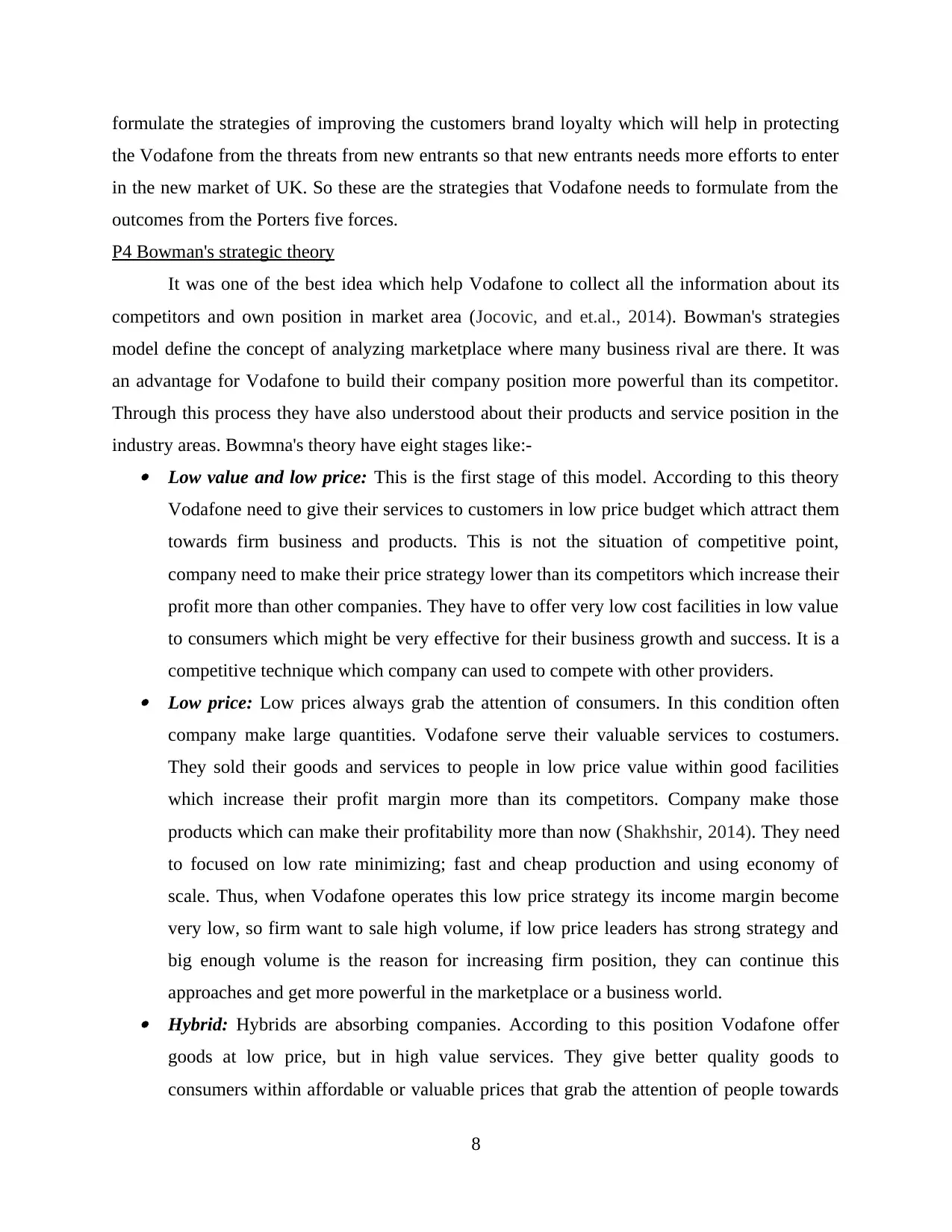
formulate the strategies of improving the customers brand loyalty which will help in protecting
the Vodafone from the threats from new entrants so that new entrants needs more efforts to enter
in the new market of UK. So these are the strategies that Vodafone needs to formulate from the
outcomes from the Porters five forces.
P4 Bowman's strategic theory
It was one of the best idea which help Vodafone to collect all the information about its
competitors and own position in market area (Jocovic, and et.al., 2014). Bowman's strategies
model define the concept of analyzing marketplace where many business rival are there. It was
an advantage for Vodafone to build their company position more powerful than its competitor.
Through this process they have also understood about their products and service position in the
industry areas. Bowmna's theory have eight stages like:- Low value and low price: This is the first stage of this model. According to this theory
Vodafone need to give their services to customers in low price budget which attract them
towards firm business and products. This is not the situation of competitive point,
company need to make their price strategy lower than its competitors which increase their
profit more than other companies. They have to offer very low cost facilities in low value
to consumers which might be very effective for their business growth and success. It is a
competitive technique which company can used to compete with other providers. Low price: Low prices always grab the attention of consumers. In this condition often
company make large quantities. Vodafone serve their valuable services to costumers.
They sold their goods and services to people in low price value within good facilities
which increase their profit margin more than its competitors. Company make those
products which can make their profitability more than now (Shakhshir, 2014). They need
to focused on low rate minimizing; fast and cheap production and using economy of
scale. Thus, when Vodafone operates this low price strategy its income margin become
very low, so firm want to sale high volume, if low price leaders has strong strategy and
big enough volume is the reason for increasing firm position, they can continue this
approaches and get more powerful in the marketplace or a business world. Hybrid: Hybrids are absorbing companies. According to this position Vodafone offer
goods at low price, but in high value services. They give better quality goods to
consumers within affordable or valuable prices that grab the attention of people towards
8
the Vodafone from the threats from new entrants so that new entrants needs more efforts to enter
in the new market of UK. So these are the strategies that Vodafone needs to formulate from the
outcomes from the Porters five forces.
P4 Bowman's strategic theory
It was one of the best idea which help Vodafone to collect all the information about its
competitors and own position in market area (Jocovic, and et.al., 2014). Bowman's strategies
model define the concept of analyzing marketplace where many business rival are there. It was
an advantage for Vodafone to build their company position more powerful than its competitor.
Through this process they have also understood about their products and service position in the
industry areas. Bowmna's theory have eight stages like:- Low value and low price: This is the first stage of this model. According to this theory
Vodafone need to give their services to customers in low price budget which attract them
towards firm business and products. This is not the situation of competitive point,
company need to make their price strategy lower than its competitors which increase their
profit more than other companies. They have to offer very low cost facilities in low value
to consumers which might be very effective for their business growth and success. It is a
competitive technique which company can used to compete with other providers. Low price: Low prices always grab the attention of consumers. In this condition often
company make large quantities. Vodafone serve their valuable services to costumers.
They sold their goods and services to people in low price value within good facilities
which increase their profit margin more than its competitors. Company make those
products which can make their profitability more than now (Shakhshir, 2014). They need
to focused on low rate minimizing; fast and cheap production and using economy of
scale. Thus, when Vodafone operates this low price strategy its income margin become
very low, so firm want to sale high volume, if low price leaders has strong strategy and
big enough volume is the reason for increasing firm position, they can continue this
approaches and get more powerful in the marketplace or a business world. Hybrid: Hybrids are absorbing companies. According to this position Vodafone offer
goods at low price, but in high value services. They give better quality goods to
consumers within affordable or valuable prices that grab the attention of people towards
8
Paraphrase This Document
Need a fresh take? Get an instant paraphrase of this document with our AI Paraphraser
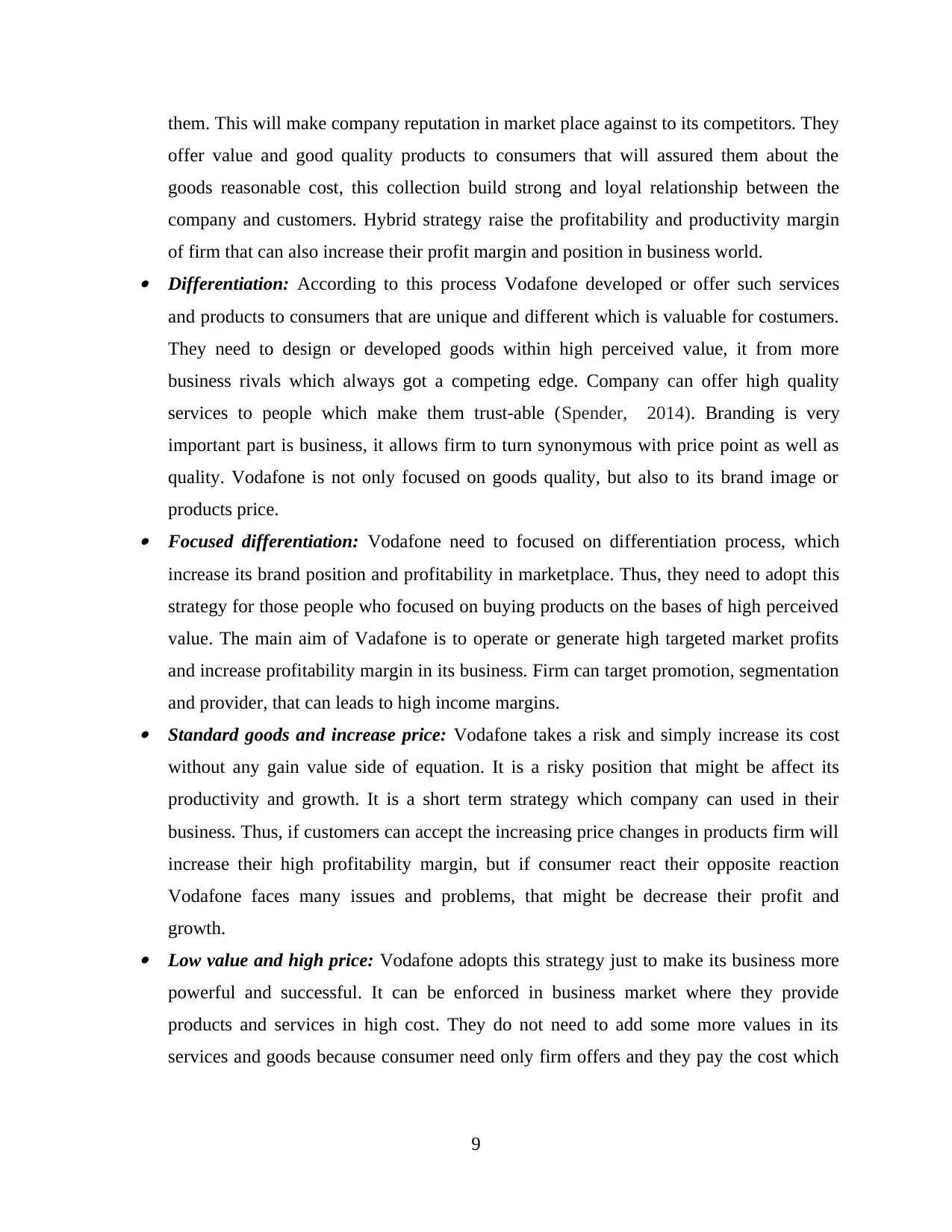
them. This will make company reputation in market place against to its competitors. They
offer value and good quality products to consumers that will assured them about the
goods reasonable cost, this collection build strong and loyal relationship between the
company and customers. Hybrid strategy raise the profitability and productivity margin
of firm that can also increase their profit margin and position in business world. Differentiation: According to this process Vodafone developed or offer such services
and products to consumers that are unique and different which is valuable for costumers.
They need to design or developed goods within high perceived value, it from more
business rivals which always got a competing edge. Company can offer high quality
services to people which make them trust-able (Spender, 2014). Branding is very
important part is business, it allows firm to turn synonymous with price point as well as
quality. Vodafone is not only focused on goods quality, but also to its brand image or
products price. Focused differentiation: Vodafone need to focused on differentiation process, which
increase its brand position and profitability in marketplace. Thus, they need to adopt this
strategy for those people who focused on buying products on the bases of high perceived
value. The main aim of Vadafone is to operate or generate high targeted market profits
and increase profitability margin in its business. Firm can target promotion, segmentation
and provider, that can leads to high income margins. Standard goods and increase price: Vodafone takes a risk and simply increase its cost
without any gain value side of equation. It is a risky position that might be affect its
productivity and growth. It is a short term strategy which company can used in their
business. Thus, if customers can accept the increasing price changes in products firm will
increase their high profitability margin, but if consumer react their opposite reaction
Vodafone faces many issues and problems, that might be decrease their profit and
growth. Low value and high price: Vodafone adopts this strategy just to make its business more
powerful and successful. It can be enforced in business market where they provide
products and services in high cost. They do not need to add some more values in its
services and goods because consumer need only firm offers and they pay the cost which
9
offer value and good quality products to consumers that will assured them about the
goods reasonable cost, this collection build strong and loyal relationship between the
company and customers. Hybrid strategy raise the profitability and productivity margin
of firm that can also increase their profit margin and position in business world. Differentiation: According to this process Vodafone developed or offer such services
and products to consumers that are unique and different which is valuable for costumers.
They need to design or developed goods within high perceived value, it from more
business rivals which always got a competing edge. Company can offer high quality
services to people which make them trust-able (Spender, 2014). Branding is very
important part is business, it allows firm to turn synonymous with price point as well as
quality. Vodafone is not only focused on goods quality, but also to its brand image or
products price. Focused differentiation: Vodafone need to focused on differentiation process, which
increase its brand position and profitability in marketplace. Thus, they need to adopt this
strategy for those people who focused on buying products on the bases of high perceived
value. The main aim of Vadafone is to operate or generate high targeted market profits
and increase profitability margin in its business. Firm can target promotion, segmentation
and provider, that can leads to high income margins. Standard goods and increase price: Vodafone takes a risk and simply increase its cost
without any gain value side of equation. It is a risky position that might be affect its
productivity and growth. It is a short term strategy which company can used in their
business. Thus, if customers can accept the increasing price changes in products firm will
increase their high profitability margin, but if consumer react their opposite reaction
Vodafone faces many issues and problems, that might be decrease their profit and
growth. Low value and high price: Vodafone adopts this strategy just to make its business more
powerful and successful. It can be enforced in business market where they provide
products and services in high cost. They do not need to add some more values in its
services and goods because consumer need only firm offers and they pay the cost which
9
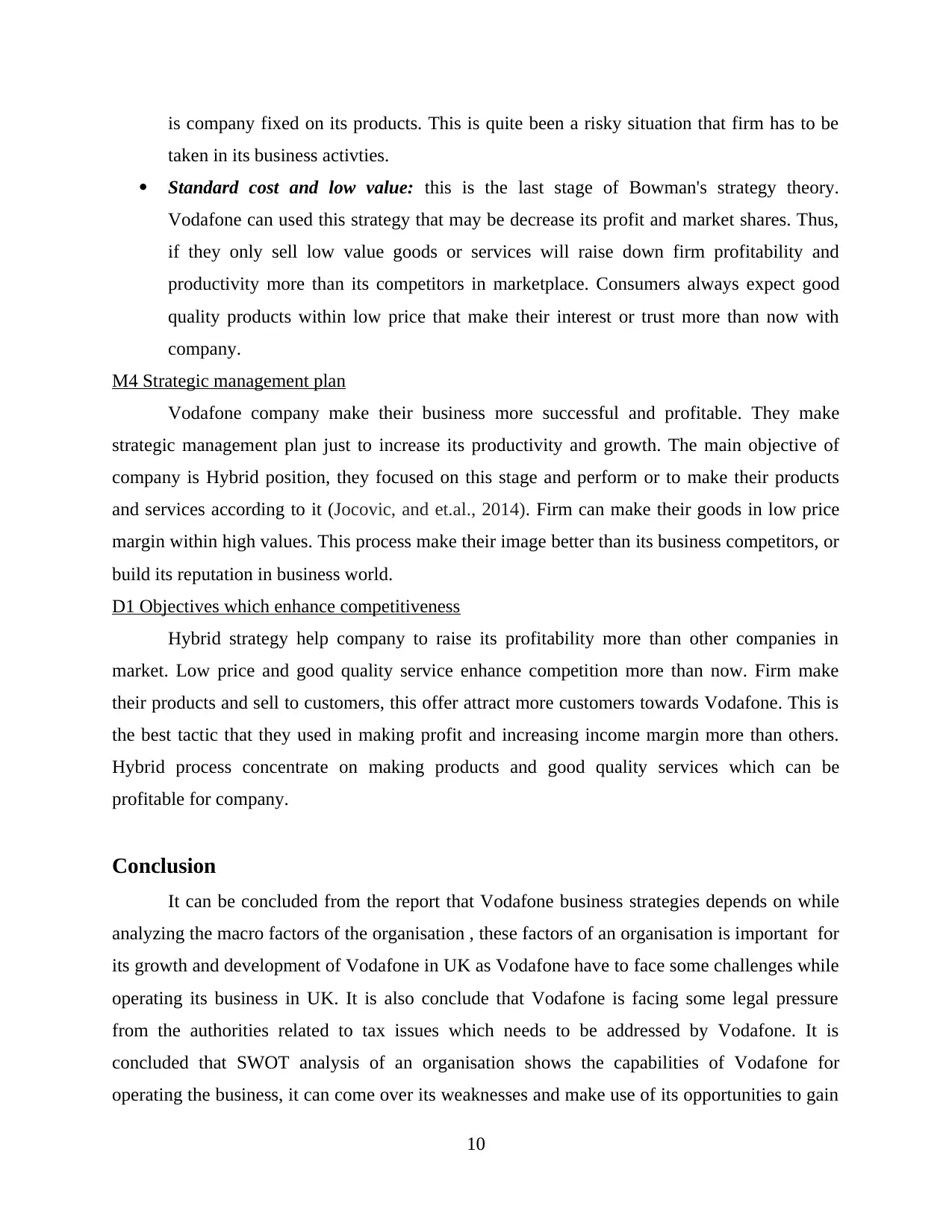
is company fixed on its products. This is quite been a risky situation that firm has to be
taken in its business activties.
Standard cost and low value: this is the last stage of Bowman's strategy theory.
Vodafone can used this strategy that may be decrease its profit and market shares. Thus,
if they only sell low value goods or services will raise down firm profitability and
productivity more than its competitors in marketplace. Consumers always expect good
quality products within low price that make their interest or trust more than now with
company.
M4 Strategic management plan
Vodafone company make their business more successful and profitable. They make
strategic management plan just to increase its productivity and growth. The main objective of
company is Hybrid position, they focused on this stage and perform or to make their products
and services according to it (Jocovic, and et.al., 2014). Firm can make their goods in low price
margin within high values. This process make their image better than its business competitors, or
build its reputation in business world.
D1 Objectives which enhance competitiveness
Hybrid strategy help company to raise its profitability more than other companies in
market. Low price and good quality service enhance competition more than now. Firm make
their products and sell to customers, this offer attract more customers towards Vodafone. This is
the best tactic that they used in making profit and increasing income margin more than others.
Hybrid process concentrate on making products and good quality services which can be
profitable for company.
Conclusion
It can be concluded from the report that Vodafone business strategies depends on while
analyzing the macro factors of the organisation , these factors of an organisation is important for
its growth and development of Vodafone in UK as Vodafone have to face some challenges while
operating its business in UK. It is also conclude that Vodafone is facing some legal pressure
from the authorities related to tax issues which needs to be addressed by Vodafone. It is
concluded that SWOT analysis of an organisation shows the capabilities of Vodafone for
operating the business, it can come over its weaknesses and make use of its opportunities to gain
10
taken in its business activties.
Standard cost and low value: this is the last stage of Bowman's strategy theory.
Vodafone can used this strategy that may be decrease its profit and market shares. Thus,
if they only sell low value goods or services will raise down firm profitability and
productivity more than its competitors in marketplace. Consumers always expect good
quality products within low price that make their interest or trust more than now with
company.
M4 Strategic management plan
Vodafone company make their business more successful and profitable. They make
strategic management plan just to increase its productivity and growth. The main objective of
company is Hybrid position, they focused on this stage and perform or to make their products
and services according to it (Jocovic, and et.al., 2014). Firm can make their goods in low price
margin within high values. This process make their image better than its business competitors, or
build its reputation in business world.
D1 Objectives which enhance competitiveness
Hybrid strategy help company to raise its profitability more than other companies in
market. Low price and good quality service enhance competition more than now. Firm make
their products and sell to customers, this offer attract more customers towards Vodafone. This is
the best tactic that they used in making profit and increasing income margin more than others.
Hybrid process concentrate on making products and good quality services which can be
profitable for company.
Conclusion
It can be concluded from the report that Vodafone business strategies depends on while
analyzing the macro factors of the organisation , these factors of an organisation is important for
its growth and development of Vodafone in UK as Vodafone have to face some challenges while
operating its business in UK. It is also conclude that Vodafone is facing some legal pressure
from the authorities related to tax issues which needs to be addressed by Vodafone. It is
concluded that SWOT analysis of an organisation shows the capabilities of Vodafone for
operating the business, it can come over its weaknesses and make use of its opportunities to gain
10
⊘ This is a preview!⊘
Do you want full access?
Subscribe today to unlock all pages.

Trusted by 1+ million students worldwide
1 out of 15
Related Documents
Your All-in-One AI-Powered Toolkit for Academic Success.
+13062052269
info@desklib.com
Available 24*7 on WhatsApp / Email
![[object Object]](/_next/static/media/star-bottom.7253800d.svg)
Unlock your academic potential
Copyright © 2020–2025 A2Z Services. All Rights Reserved. Developed and managed by ZUCOL.





